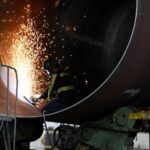By Tom Ozimek
A closely watched gauge of U.S. business investment surged in September, signaling a burst of momentum across America’s industrial sector and reinforcing signs that manufacturing is regaining strength after a volatile start to the year.
Non-defense capital goods orders excluding aircraft—a key proxy for business spending on equipment—rose by 0.9 percent last month, far outpacing economists’ forecasts for a 0.2 percent increase, according to a delayed U.S. Census Bureau report released Nov. 26 following the 43-day federal shutdown.
Shipments of core capital goods, which feed directly into gross domestic product (GDP) calculations, also jumped by 0.9 percent after slipping by 0.1 percent in August.
Some economists said the rebound pointed to firm investment demand heading into the fourth quarter despite volatility earlier in the year tied to President Donald Trump’s tariffs on imports.
“Core capital goods orders & shipments have swung wildly since the start of the year, but momentum in Q3 was solid, driven by communications equipment, machinery & primary metals,” Gregory Daco, chief economist at EY-Parthenon, said in a post on X.
Orders for raw metals and fabricated metal products rose at one of the strongest clips of the year, while electrical equipment and appliance orders climbed by 1.5 percent on the month and are up by 5 percent year-to-date, hinting at possible substitution away from foreign producers.
Overall durable goods orders increased by 0.5 percent in September, matching consensus forecasts and marking a second straight monthly gain.
Some analysts saw deeper signs of industrial strengthening in the census data, pointing to broad-based gains across core categories that suggest U.S. manufacturers are building momentum.
“More telling is the breadth of the core gain. When firms increase orders outside of big-ticket transport items, it reflects confidence in multi-quarter demand visibility,” Naeem Aslam, CIO at Zaye Capital Markets, wrote in a post on X. “This is the kind of investment behavior that historically precedes productivity lifts, margin stabilization, and renewed industrial hiring. Pair that with lower jobless claims, and you get an economy balancing firmness with disinflation.”
The Census Bureau’s release of the core capital goods data came on the same day that the Department of Labor reported that initial jobless claims fell by 6,000 to 216,000 for the week ended Nov. 22, the lowest level since mid-April.
Other data released last week suggest the rise in core capital goods orders aligns with a broader improvement in U.S. business activity.
Momentum Builds in Manufacturing and Services
S&P Global’s flash composite PMI (purchasing managers’ index) climbed to 54.8 in November, a four-month high signaling roughly 2.5 percent annualized GDP growth early in the fourth quarter. New orders posted their strongest increase of the year, with service-sector demand accelerating and manufacturing output expanding for a sixth straight month.
“The flash PMI data point to a relatively buoyant U.S. economy in November,” Chris Williamson, chief business economist at S&P Global Market Intelligence, said in a statement. “The upturn also looks encouragingly broad-based for now, with output rising across both manufacturing and the vast services economy.”
New manufacturing orders grew modestly amid another month of falling exports, but production remained solid—partly supported by domestic demand and stockpiling. However, the PMI survey also showed a record buildup in finished-goods inventories for the second straight month, raising concerns that production may need to slow unless global demand improves.
“This accumulation of unsold inventory hints at slower factory production expansion in the coming months unless demand revives,” Williamson said, adding that this could drive slower growth in some service industries.
The S&P Global report showed private-sector employment grew in November but at a subdued pace as firms grappled with higher input costs and tighter budgets. Manufacturers reported the fastest hiring in three months, even as some companies delayed recruitment to offset cost pressures.
The latest Bureau of Labor Statistics jobs report for September—released late because of the shutdown—showed the economy added 119,000 jobs, more than double expectations, though manufacturing shed 6,000 positions amid weaker goods demand and high inventories.
Meanwhile, a new year-end outlook from the National Association for Business Economics, also released this week, shows forecasters upgrading 2026 GDP growth expectations to 2.0 percent, up from 1.8 percent in October and 1.3 percent in June.
Economists cited firmer consumer spending, improved investment conditions, and resilient domestic demand.





